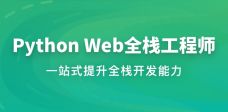Python 是一种高级编程语言,因其简洁、易读的语法而受到广泛欢迎。它适用于多种应用场景,包括但不限于网站开发、数据分析、人工智能和机器学习。Python 被认为是初学者学习编程的理想语言,也是高级开发人员常用的工具之一。
Python安装与环境搭建Python 安装过程简单直接。推荐使用 Python 官方安装包进行安装,可以从 Python 官方网站下载安装包。安装完成后,可以通过命令行验证是否安装成功:
python --version对于开发环境的搭建,推荐使用集成开发环境(IDE)如 PyCharm,或者轻量级代码编辑器如 VS Code。这些工具提供了强大的代码编辑、调试和测试功能。
Python语法基础Python变量与数据类型
Python 中的变量无需声明类型,但在使用时需要赋值。Python 支持多种基本数据类型,包括整型(int)、浮点型(float)、布尔型(bool)、字符串(str)和列表(list)等。
# 定义变量
integer = 10
float_num = 3.14
boolean = True
string = "Hello, World!"
list_data = [1, 2, 3, 4, 5]
# 输出变量类型
print(type(integer))
print(type(float_num))
print(type(boolean))
print(type(string))
print(type(list_data))Python基本语法结构
变量赋值
x = 10
y = 20字符串操作
greeting = "Hello"
name = "World"
message = greeting + ", " + name + "!"
print(message)条件语句
age = 18
if age >= 18:
print("成年人")
else:
print("未成年人")循环语句
for i in range(5):
print(i)函数定义与调用
def greet(name):
return "Hello, " + name + "!"
print(greet("Alice"))异常处理
try:
x = 1 / 0
except ZeroDivisionError:
print("不能除以零")列表与元组
列表是可变的数据结构,可以存储不同类型的元素。元组是不可变的,一旦创建就不能更改。
# 定义列表
list_example = [1, 2, 3, 4, 5]
list_example.append(6) # 添加元素
print(list_example)
# 定义元组
tuple_example = (1, 2, 3, 4, 5)
# tuple_example[0] = 10 # 不能修改元组中的元素
print(tuple_example)元组在不可变性方面有其独特优势,适用于需要确保数据稳定性的场景。例如,一个程序中需要固定一些配置项,使用元组可以防止这些配置项被意外修改。
字典与集合
字典是一个无序的键值对集合,集合是一个无序的不重复元素集合。
# 定义字典
dictionary = {"name": "Alice", "age": 25}
print(dictionary["name"])
# 定义集合
set_example = {1, 2, 3, 4, 5}
print(set_example)
``
### 函数与模块
Python 支持函数调用、参数传递和返回值。模块是包含 Python 代码的文件,可以包含函数、类等。
```python
def add(a, b):
return a + b
print(add(1, 2))
# 导入模块
import math
print(math.sqrt(16))面向对象编程
Python 是一种面向对象的语言,支持类和对象的定义。面向对象编程使得代码更加模块化和可重用。
class Person:
def __init__(self, name):
self.name = name
def greet(self):
return "Hello, " + self.name + "!"
p = Person("Alice")
print(p.greet())面向对象编程的核心概念包括类和对象。类是对象的蓝图,定义了对象的属性和方法。对象是类的实例,具有类定义的所有属性和方法。例如,上述代码定义了 Person 类,它有一个属性 name 和一个方法 greet,实例化 Person 类后可以调用其方法。
文件操作
Python 提供了多种文件读写方式,可以操作文本文件和二进制文件。
# 写文件
file = open("example.txt", "w")
file.write("Hello, World!")
file.close()
# 读文件
file = open("example.txt", "r")
content = file.read()
print(content)
file.close()
``
文件操作可以通过上下文管理器简化,避免手动关闭文件。例如:
```python
with open("example.txt", "w") as file:
file.write("Hello, World!")
with open("example.txt", "r") as file:
content = file.read()
print(content)Web爬虫
Python 在网络应用开发中非常有用,下面是一个简单的网页爬虫示例,展示如何获取网页标题:
import requests
from bs4 import BeautifulSoup
url = "https://www.example.com"
response = requests.get(url)
soup = BeautifulSoup(response.text, "html.parser")
title = soup.title.string
print(title)更复杂的网页结构可能需要解析多个标签和属性。例如,如果需要从网页中提取所有的链接,可以使用以下代码:
links = soup.find_all('a')
for link in links:
print(link.get('href'))数据分析
Python 在数据分析领域非常受欢迎,这里演示一个简单的数据分析示例,展示如何创建和操作数据框:
import pandas as pd
# 创建 DataFrame
data = {
'Name': ['Alice', 'Bob', 'Charlie'],
'Age': [25, 30, 35],
'Gender': ['Female', 'Male', 'Male']
}
df = pd.DataFrame(data)
# 打印 DataFrame
print(df)
# 计算平均年龄
mean_age = df['Age'].mean()
print("平均年龄:", mean_age)在这个示例中,我们创建了一个包含名字、年龄和性别的数据框,并计算了平均年龄。
机器学习
Python 是机器学习领域的主流语言之一。这里演示一个简单的线性回归模型,展示如何使用 scikit-learn 库进行训练和预测:
import numpy as np
from sklearn.linear_model import LinearRegression
# 生成一些数据
X = np.array([5, 15, 25, 35, 45, 55]).reshape((-1, 1))
y = np.array([5, 20, 14, 32, 22, 38])
# 创建线性回归模型
model = LinearRegression()
model.fit(X, y)
# 预测新的数据点
new_data = np.array([10, 20, 30]).reshape((-1, 1))
predictions = model.predict(new_data)
print(predictions)在这个示例中,我们使用 scikit-learn 的 LinearRegression 模型拟合数据,并预测了新的数据点值。
常用库介绍
Python 生态系统中有许多强大的库,这里列出几个常用的库:
- requests:用于发送 HTTP 请求。
import requests
response = requests.get('https://www.example.com')
print(response.status_code)- BeautifulSoup:用于解析 HTML 和 XML 文件。
from bs4 import BeautifulSoup
html_doc = """
<html>
<head>
<title>Sample Page</title>
</head>
<body>
<h1>Hello, World!</h1>
</body>
</html>
"""
soup = BeautifulSoup(html_doc, 'html.parser')
title = soup.title.string
print(title)- pandas:用于数据分析和处理。
import pandas as pd
# 创建 DataFrame
data = {'Name': ['Alice', 'Bob', 'Charlie'], 'Age': [25, 30, 35]}
df = pd.DataFrame(data)
# 打印 DataFrame
print(df)- numpy:用于科学计算。
import numpy as np
array = np.array([1, 2, 3, 4, 5])
print(array)- scikit-learn:用于机器学习。
from sklearn.linear_model import LinearRegression
X = np.array([5, 15, 25, 35, 45, 55]).reshape((-1, 1))
y = np.array([5, 20, 14, 32, 22, 38])
model = LinearRegression()
model.fit(X, y)
new_data = np.array([10, 20, 30]).reshape((-1, 1))
predictions = model.predict(new_data)
print(predictions)- matplotlib:用于绘图和可视化。
import matplotlib.pyplot as plt
x = np.array([1, 2, 3, 4, 5])
y = np.array([10, 20, 30, 40, 50])
plt.plot(x, y)
plt.xlabel('X axis')
plt.ylabel('Y axis')
plt.title('Sample Plot')
plt.show()常用框架介绍
- Django:一个高级的 Python Web 框架,鼓励快速开发和干净、简约的设计。
from django.http import HttpResponse
from django.views import View
def hello_world(request):
return HttpResponse("Hello, World!")
class HelloWorldView(View):
def get(self, request):
return HttpResponse("Hello, World from class-based view!")- Flask:一个轻量级的 Web 应用框架,具有灵活性和易用性。
from flask import Flask
app = Flask(__name__)
@app.route('/')
def hello_world():
return 'Hello, World!'
if __name__ == '__main__':
app.run()- Tornado:一个 Python Web 服务器和 web 框架,适用于可扩展的实时应用。
from tornado import web, ioloop
class MainHandler(web.RequestHandler):
def get(self):
self.write("Hello, World!")
application = web.Application([
(r"/", MainHandler),
])
if __name__ == "__main__":
application.listen(8888)
ioloop.IOLoop.current().start()Python 是一门强大且易用的编程语言,适用于多种应用领域。不论是初学者还是有经验的开发者都能从 Python 中受益。通过本文的介绍,希望读者能够对 Python 的语法、高级特性和常用库与框架有基本的了解。建议通过实际项目来实践和深入学习 Python,以更好地掌握这门语言。
参考资料
- Python 官方文档:https://docs.python.org/3/
- 慕课网 Python 课程:https://www.imooc.com/course/list/python
- Peter Norton, Python Crash Course

 随时随地看视频
随时随地看视频




